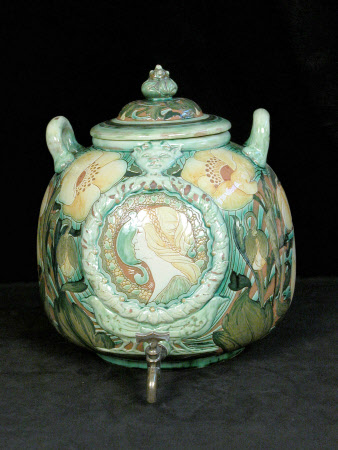Cistern
Della Robbia Pottery
Category
Ceramics
Date
1899 - 1902
Materials
red earthenware with pale slip and coloured glazes
Measurements
360 mm (H)
Place of origin
Birkenhead
Order this imageCollection
Wightwick Manor, West Midlands
NT 1287684
Summary
Two handled urn and cover, red earthenware with pale slip, globular body with low, distinct foot, with two upright U-shaped handles attached at the shoulder, short beaded neck, domed cover with flange and bud shaped knop, brass spigot at the lower of the body, decorated by Cassandra Annie Walker, Della Robbia Pottery, Birkenhead, ca 1899-1902; decorated around the body with sgraffito flowers and buds on leafy stems, at the centre of the body an image of woman in profile facing proper right, surrounded by a moulded circular frame formed of a reeded wreath with a grotesque, the design coloured with yellow, green and blue glazes.
Full description
Cassandra Annie Walker (1875-1936) grew up in Liverpool and worked at the short-lived Della Robbia Pottery in Birkenhead, which operated from 1894-1906. Taking its name and inspiration from the maiolica (tin glazed earthenware) masterpieces of Italian Renaissance sculptor Luca Della Robbia, the studio was established according to Arts and Crafts principles, aspiring to use local labour and materials, and to create works entirely by hand. Della Robbia employed many women as designers and decorators and Walker’s work is among its very finest and most progressive. The ceramics were bold, bright and colourful – the Magazine of Art reported that, with Della Robbia ceramics in a room, ‘the ordinary meal would have the comparative air of a banquet.’ Unfortunately, the venture was never profitable and it closed after just 12 years in business. While working at Della Robbia, Walker attended Liverpool School of Architecture and Applied Art, and won a scholarship from the Liverpool Corporation to study at Westminster School of Art. She described her profession as ‘pottery designer’ and was entrusted with a number of important commissions for Della Robbia. Walker was particularly interested in architectural ceramics and exhibited several wall panels and reliefs at Liverpool’s Walker Art Gallery, attracting critical praise in contemporary art publications such as The Studio. Walker is remembered as ‘a woman of independent ways and behaviour’, who often wore a long, flowing Arabic-style cloak while walking around Liverpool. Walker had an affinity for figurative work and attended evening life classes as part of her training in 1901-2. This is shown to beautiful effect in the portrait on this urn – vessels of this type often featured images of the image of a woman. While Art Nouveau in style, the pale ground colour, flattened perspective and reeded wreath frame are inspired by sixteenth century Italian maiolica Belle Donne portrait plates. Harold Rathbone was the founder of and driving force behind the Della Robbia Pottery. He trained at the Slade School of Art and then at the Académie Julian in Paris. In 1878, he visited Italy with his family, where encountered the work of fifteenth century ceramicist and sculptor, Luca Della Robbia. Rathbone based himself in London and exhibited work widely. Rathbone’s father was a prolific patron of the arts and the family was well known in Pre-Raphaelite circles. By the time he established the Della Robbia Pottery, Rathbone was connected to many distinguished artists and thinkers, including John Ruskin, Mary Seton Watts and George Frederic Watts, Ford Maddox Brown and Frank Brangwyn.
Provenance
Miss Dorothy Pettitt, her Aunt Lavinia, Della Robbia Birkenhead
Marks and inscriptions
Underside of base: CAW (mark of Cassandra Annie Walker) D [ship] R (mark of Della Robbia)
Makers and roles
Della Robbia Pottery , maker Cassandra Annie Walker (1875 - 1936), designer
References
Hyland 2013: Peter Hyland, The Della Robbia Pottery, Birkenhead, 1894-1906, Suffolk: Antique Collectors’ Club 2013
